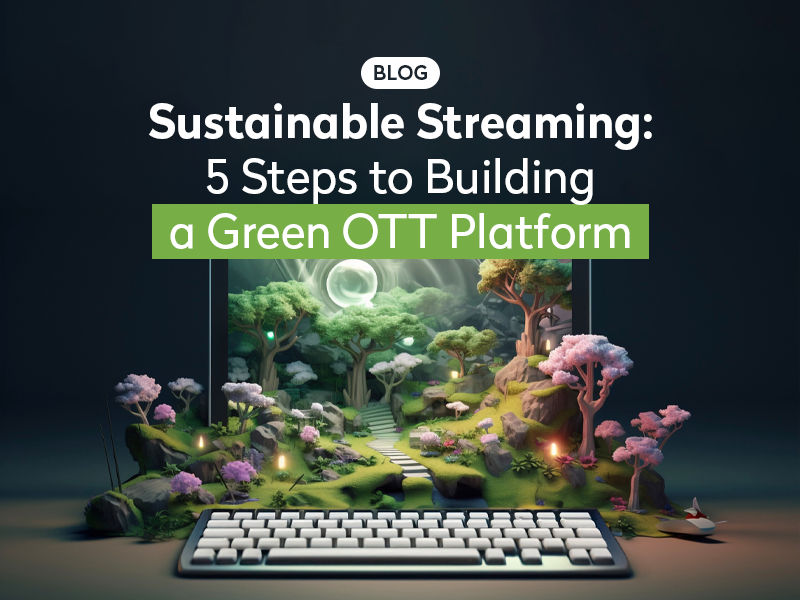Sustainable streaming: 5 Steps to building a green OTT platform
- Green streaming
In today's digital era, Over-The-Top (OTT) streaming services have emerged as a dominant force in the media and entertainment landscape.
With the rise of on-demand content, the demand for OTT services continues to skyrocket, offering viewers the best viewing experience and unparalleled access to a vast array of content anytime, anywhere.
However, as the popularity of OTT platforms grows, so does the need for sustainability within the industry.
As environmental challenges increase in the world, the need for sustainability in every sector of the economy becomes increasingly urgent, and the OTT industry is no exception. With the popularity of streaming services today, there comes a significant environmental impact, from energy consumption to electronic waste.
The digital industry’s carbon footprint, which is growing at an average rate of 6% per year, already accounts for 3% to 4% of global emissions today, with streaming media accounting for over 1% of this consumption. Seems low, right? Well, not quite – while this 1% may seem insignificant, it becomes noteworthy when compared to the airline industry, which is estimated to be 1.9%. What’s more concerning is that this percentage is projected to increase as streaming continues to grow in demand.
So, how can streaming operators balance thorough monitoring with reducing their environmental impact?

The backbone of any OTT platform lies in its data centers and infrastructure. By leveraging energy-efficient hardware, optimizing server utilization, and adopting renewable energy sources, streaming operators can significantly reduce their carbon footprint. Implementing advanced cooling technologies, such as liquid cooling systems or free cooling, can further enhance energy efficiency and reduce environmental impact.
Additionally, consolidating servers and leveraging cloud-based solutions can streamline operations and minimize energy consumption. By prioritizing sustainability in data center design and management, streaming operators can lay a solid foundation for a greener streaming platform.
Encoding and transcoding are essential processes in content preparation, but they can also consume significant energy if not optimized. Streaming operators can adopt energy-efficient encoding and transcoding techniques to minimize energy consumption while maintaining video quality.
Utilize advanced codec technologies, such as HEVC (High-Efficiency Video Coding), to reduce bandwidth requirements and lower energy consumption during content delivery.
Implement parallel processing and distributed transcoding techniques to optimize resource utilization and minimize energy usage.
Additionally, consider implementing dynamic bitrate adaptation algorithms to adjust video quality based on network conditions and viewer preferences, further reducing energy consumption. By adopting energy-efficient encoding and transcoding techniques, streaming operators can minimize their environmental impact without compromising video quality.
Sustainable CDNs play a crucial role in reducing the environmental impact of content delivery. Streaming operators can partner with CDN providers that prioritize energy efficiency and sustainability.
Look for CDN providers that utilize renewable energy sources for their data centers and employ optimization techniques to minimize energy consumption during content delivery.
Moreover, implement caching and edge computing strategies to reduce the distance traveled by content and minimize server load. By optimizing content delivery processes and partnering with sustainable CDN providers, streaming operators can minimize their carbon footprint while ensuring high-quality content delivery.
Sustainable software development practices can significantly reduce the environmental impact of OTT platforms. Streaming operators can prioritize efficient code architecture, optimize algorithms, and minimize resource-intensive processes to reduce energy consumption during software operation.
Embrace modular design principles and microservices architecture to enable scalability and flexibility while minimizing resource overhead. Implement efficient data caching and retrieval mechanisms to reduce server load and energy consumption.
Additionally, prioritize code optimization and performance tuning to minimize CPU and memory usage, further reducing energy consumption. By prioritizing sustainable software development practices, streaming operators can minimize their carbon footprint while delivering high-performance OTT platforms.
User engagement and education play a crucial role in promoting sustainability in the OTT industry. Streaming operators can implement features that encourage users to adopt eco-friendly viewing habits, such as energy-saving modes, personalized recommendations for environmentally conscious content, and carbon footprint tracking tools.
Educate users about the environmental impact of streaming media and provide tips on how they can reduce their carbon footprint, such as streaming in standard definition, minimizing idle streaming, and supporting sustainable content creators.
By promoting user engagement and education on sustainability, streaming operators can empower users to make informed choices and contribute to a greener future.
At Alpha Networks, we understand the importance of sustainability in the digital landscape. Our suite of solutions is designed to help you build an eco-conscious OTT platform from the ground up.
With our optimized technologies and commitment to renewable energy hosting, you can launch a streaming service that not only captivates your audience but also minimizes its environmental footprint.
Adopting sustainable practices in OTT streaming is vital for reducing environmental impact. By optimizing infrastructure, adopting sustainable CDNs, using energy-efficient encoding, prioritizing sustainable development, and promoting user engagement, we can create a greener future for streaming.
Ready to make a positive impact? Let's build a sustainable streaming solution together. Contact us today and let's get started!
Alpha Networks proudly introduces DeltaUX, an innovative solution set to transform content discovery across streaming platforms.
Read publicationBrisanet, a major telecommunications company and largest regional ISP in the North-East region of Brazil, launched an improved ver...
Read publicationAlpha Networks and Digital Virgo are joining forces to present a proven all-in-one OTT ecosystem designed for telecom operators an...
Read publicationPrepare to share your content with top-notch products.
Take control of your content and share it with the world. Be part of the TV revolution today.
Talk to an expert